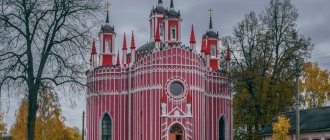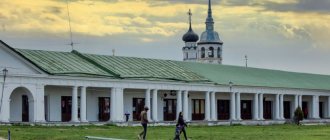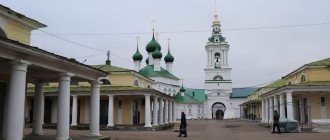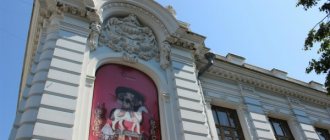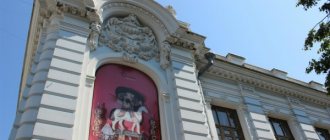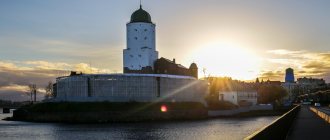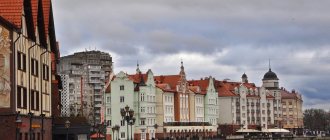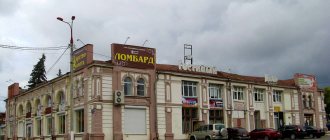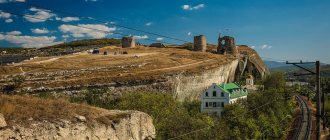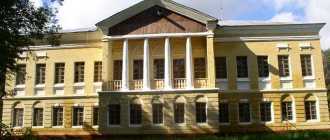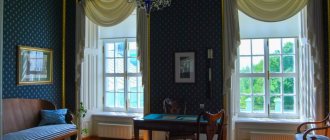Modern Tver is a city with picturesque embankments, ancient architecture, ancient mansions, beautiful churches and interesting museums. In this article we will tell you what to see in Tver on your own if you only have one day to get to know the city.
Tver is located on the banks of the Volga River at the confluence of the Tvertsa and Tmaka rivers. The two banks are connected by bridges - Starovolzhsky, built in 1900, Novovolzhsky, borrowed from St. Petersburg, and two more bridges on the outskirts of the city.
How to get to Tver from Moscow
- On Sapsan: Departure there: 06:50, 07:00, 9:20
- Return departure: 19:45, 21:49
- Travel time: ~1 hour 10 minutes
- Ticket price: from 1600 rub. one way
- Departure there: 06:58, 07:47, 8:46
- Departure there: 07:03
- Along the “old” Leningradka: 150 km, ~2.5 hours
What is the most profitable and cheaper way to go to Tver?
- The cheapest and longest option is a regular train .
- The best option: in order not to get up very early in the morning, you can choose Sapsan for the route there with departure at 9:20 and be in Tver by 10:30. And for the return journey, use Lastochka or a regular train.
- In a large group, you can travel by car : the cost of travel for 4 people on a round-trip train will be comparable to the cost of gasoline and the payment of toll sections . And if you leave early in the morning, then there is a chance to make it before the morning traffic jams and save additional money by traveling part of the route along the free Leningradka.
Volga embankment in Tver
Each section along the Volga in the territory has its own name. In the city center, there are two embankments on the right and left banks of the river.
From the end of Sovetskaya Street it is convenient to go to one of the right banks - Stepan Razin embankment. Among its important details are the classical buildings and the monument to Andrei Dementyev, a poet, writer, editor of some famous Soviet publications and a native of Tver.
Behind the Novovolzhsky Bridge it continues with the Mikhail Yaroslavich embankment. It is the most visited, as it is located near the City Garden of Tver and the Palace Garden in front of the Imperial Palace. It offers a wonderful view of the openwork trusses of the Starovolzhsky Bridge.
On the upper promenade there is an unusual monument to A.S. Pushkin: the poet seemed to have stopped to rest at the embankment fence and remained here forever in stone. In the City Garden you will find a Ferris wheel and another monument to Mikhail Tverskoy. Pay attention to the Zvezda cinema and the Voroshilov Riflemen's House located right there - architectural monuments of the pre-war years. A staircase leads to the lower tier; pleasure boats depart from its pier in the summer.
The left bank embankment is named after Afanasy Nikitin, and a monument to him is erected here. Afanasy Nikitin is a famous Tver navigator of the 15th century who visited India. From here on the pedestal is the bow of the ship, decorated with the head of a horse. Behind it stands the Church of the Three Confessors. The Zavolzhsky Park runs along the promenade - a pleasant place for leisurely exercise, viewing the panorama of the other side, or even relaxing on the City Beach in the summer. There is another monument in it - to the Submariners of the Second World War.
At the confluence of the Tvertsa River and the Volga stands an outstanding landmark on the left bank - Tver River Station, built in 1938. In its center there are two round parts with columns. The beautiful, majestic building, unfortunately, has not been used for a long time and is therefore actually ruins. It is hidden from the water by an alley, in front of which there is an art object in the form of the letters “TVER”.
Across Tvertsa there is a cozy but little popular coastal street called the Volga River embankment. Along it stand old and new mansions and the St. Catherine's Monastery.
What is the best way to build a route around Tver?
Almost all attractions are close to each other, except for the Proletarka Courtyard:
There are two route options:
- From the railway station, first get to Dvor Proletarka: - The fastest option is to take the Tver-Bologoe train one stop to the station. Proletarskaya and walk about 10 minutes - Longer options: buses 7 and 10 to the Railway Hospital stop, and then ~15 minutes on foot. See the schedule and route on Yandex.Maps After Proletarka Yard, go to the center (there are many buses from different stops, see Yandex.Maps) and walk around the central part until the evening.
- Start your inspection from the central part, and leave the Proletarka Courtyard for the evening.
I would recommend the first option, because... It is better to look at the yard during daylight hours and it is logistically more convenient to first go to the Proletarsky district and then take a leisurely walk around the center. In the center, in addition to attractions, there are many cafes and restaurants.
A Google map with marked points on the route is available at: https://goo.gl/maps/mtRx9GTzFDSqCUwh6
✅ Visited by the author : in 2022.
What to see in Tver in 1 day: attractions
Tver is a small city, the main tourist sites of which are located a short distance from each other. Thanks to this, getting to know them will not take much time even for those who travel without a car.
Proletarka
Morozovsky town, nicknamed “Proletarka’s Courtyard” in Soviet times, is an ancient quarter built in the mid-19th – early 20th centuries. barracks, utility and industrial buildings belonging to the Morozov textile manufactory.
The houses are built of red brick, their facades are dominated by Art Nouveau and Gothic influences. Metal and reinforced concrete structures were actively used in construction.
There are about 50 houses in the Morozovsky city, among which the greatest architectural and historical value are:
- People's Theatre;
- barracks "Paris";
- observatory.
Proletarka village made of red brick.
Cathedral of the Nativity
During an independent tour of Tver, I advise you to visit the Nativity of Christ convent. On its territory is the Cathedral of the Nativity of Christ, one of the largest Orthodox churches in the city, built in 1810–1820. designed by the famous architect Carlo Rossi.
The five-domed monumental cathedral is a monument of late classicism. It has entrances on the south, west and north sides, each of which is decorated with porticoes supported by columns of the Tuscan order.
Imperial Travel Palace
Getting to know this attraction is included in all tourist routes around Tver.
The palace, located in the city center on Cathedral Square, is designed in the style of classicism with baroque elements. It was built in the mid-1760s. for members of the imperial family who stayed there during their travels from St. Petersburg to Moscow. In 1767, Catherine II rested here.
You will also like: Where to go and what to see in Obninsk
Today the palace building houses an art gallery.
The Imperial Travel Palace in the style of classicism.
Church "White Trinity"
This Orthodox church is the oldest stone structure in the city. It was erected in 1564, but in the 18th–19th centuries. It was rebuilt several times, as a result of which it became seven-domed, acquired a two-tier bell tower, a tent, additional altars and other extensions. During the same period, an iconostasis appeared in the church, which has survived to this day.
The main shrine of the temple, which believers from all over Russia come to see, are the relics of St. Macarius of Kalyazin.
Attend a service at the White Trinity Church.
Obelisk of Victory
The monument was inaugurated in 1970 in honor of the 29th anniversary of the liberation of Tver from the fascist invaders. It is located at the confluence of the Tmaka and the Volga, where during the Second World War, Soviet troops managed to stop the enemy on the approaches to Moscow.
The obelisk was created by a team of sculptors, architects and engineers. It is a 45-meter reinforced concrete column, decorated with bas-reliefs with images of those who defended the Motherland at the front and in the rear. At the top of the monument there is a torch bowl with the Eternal Flame.
The Obelisk of Victory is 45 meters high.
Tver Academic Drama Theater
If you walk from the Imperial Travel Palace along Sovetskaya Street, you can reach the Tverskoy Drama Theater. It is located in a majestic Stalin-era building, decorated with columns, stucco moldings and bas-reliefs. It was built on the site of a theater destroyed during the war.
The title of academic theater was awarded in 1995. Its troupe today includes 8 People's Artists of Russia. The repertoire includes 27 performances, half of which are based on works of Russian classical literature.
Chapel of Mikhail Tverskoy
Among the other things you can see in Tver in 1 day on your own, I would like to highlight the white stone chapel in the Vladimir-Suzdal style, built in 2002 in honor of the city’s patron, Prince Mikhail Tverskoy.
A small one-domed church is located on Memory Island next to the Obelisk of Victory. It stands in a picturesque place, offering a beautiful view of the Volga and its surroundings.
The Chapel of Mikhail Tverskoy was built in the Vladimir-Suzdal style.
Monument to the family
Among the attractions that have recently appeared in Tver is the bronze Family Monument. It was inaugurated in 2016 on Tverskaya Square next to the fountain.
The sculptural composition depicts a happy family consisting of spouses and their 3 children of different ages - two girls and a boy. The mother has a round belly, hinting that soon there will be another addition to the family, which everyone is looking forward to.
The figures are made in human height. Tourists like to take pictures next to them to add to their collection of photographs taken against the backdrop of unusual sights.
You will also like: The main attractions of the Olympic Park in Sochi
The monument to the family was opened in 2016.
Monument to M. E. Saltykov-Shchedrin
The bronze monument to the Russian writer was unveiled in 1976 in honor of his 150th anniversary. The authors depicted M. E. Saltykov-Shchedrin sitting in a chair with his hands on a cane. The figure of the writer is on a small graphite pedestal.
The monument stands on a cobblestone-paved area with benches around the perimeter. In the evening it is illuminated by decorative lamps.
The monument to the writer is located on Tverskaya Square within walking distance from the Family Monument.
The monument to M. E. Saltykov-Shchedrin is located on Tverskaya Square.
City Garden
Lovers of hiking should head to the City Garden. It appeared in the early 1930s. after the unification of the Public, Governor and Palace Gardens.
The park is located on the right bank of the Volga. On its territory there are attractions and cafes, and during the holidays folk festivities are held here. It is especially beautiful in the garden in autumn, when the foliage on the trees colors everything around in red, red and yellow tones.
